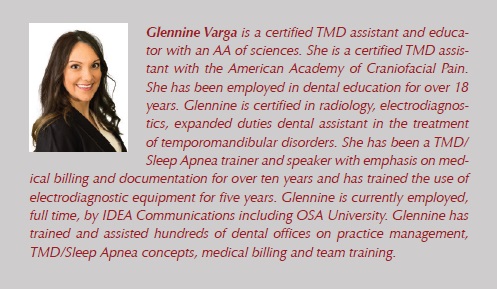
This is a remark often heard by team members in a dental sleep medicine practice, but it’s also a question. There are many factors that can affect the TM joints of patients in oral device therapy; muscle soreness, joint pain, repositioned condyles, changed bites, and sore teeth are on the list of complaints a patient may have. How do we handle this? What happens with medical insurance and what do we say to our patients? TMD is an acronym for temporomandibular dysfunction, which includes muscles, joints, and occlusion. When patients are vague about explaining a TMD issue, it may be because it’s hard to pinpoint the problem. No need to get concerned and panic – the patient will feel your fear. Instead, calmly help your patient identify and share their true concerns and brief your doctor so she/he is prepared to focus on diagnosis and solutions. The issue may have a simple solution like morning bite exercises.
Just like with OSA it is important to obtain a diagnosis. If you are in a practice that actively treats TMD patients chances are you have a protocol in place which could range from extensive history taking to CT scans. If you are in a practice that offers minimal to no TMD treatments chances are a referral would be made. In either case, communication and prevention are as fundamental as an informed consent and written homecare instructions.
A good defense is the best offense. Being upfront with patients on expectations prior to committing to treatment is everything. A strong informed consent should include information on possible side effects, what is expected of the patient and what would happen in the event of unusual symptoms or discomfort. Typically, if a problem should arise, an evaluation of the situation is needed to determine action and will be handled separately from the oral device therapy. The informed consent should be explained to the patient in detail and make sure to give patients a copy and time to look over and understand before signing. If an informed consent is absent or does not include this information get with your doctor about revising it. Dr. Berley writes about this in his column this issue.
 As great team members, we strive to support our doctors and patients to have the best experiences with therapy. Here are some suggestions that may help to reduce the number of TMD issues with oral device therapy. First, be observant while taking records for the fabrication of the device; for example, recording deflections of the jaw during protrusive measurements. If you are in charge of recording this information and you notice the jaw moving off to one side, make sure your doctor is well aware of this before taking a bite registration. Next, some practices allow patients to advance their own devices. In these situations it is critical patients know how to do it properly. Team members help make sure they do, with written instructions and hands-on practice to have patients demonstrate their understanding. Also, morning bite exercises are key in maintaining a stable bite. When the mandible is suspended in a forward position all night, synovial joint fluid can build up in the TM joints, jaw muscles can get sore and or stiff and patients may have a hard time “finding their bite”. These exercises are essential in maintaining centric occlusion and reducing possible bite changes in the future. Patients might feel questions about these areas are ‘too simple’ to ask the doctor about; that puts the team member in the perfect place to help.
As great team members, we strive to support our doctors and patients to have the best experiences with therapy. Here are some suggestions that may help to reduce the number of TMD issues with oral device therapy. First, be observant while taking records for the fabrication of the device; for example, recording deflections of the jaw during protrusive measurements. If you are in charge of recording this information and you notice the jaw moving off to one side, make sure your doctor is well aware of this before taking a bite registration. Next, some practices allow patients to advance their own devices. In these situations it is critical patients know how to do it properly. Team members help make sure they do, with written instructions and hands-on practice to have patients demonstrate their understanding. Also, morning bite exercises are key in maintaining a stable bite. When the mandible is suspended in a forward position all night, synovial joint fluid can build up in the TM joints, jaw muscles can get sore and or stiff and patients may have a hard time “finding their bite”. These exercises are essential in maintaining centric occlusion and reducing possible bite changes in the future. Patients might feel questions about these areas are ‘too simple’ to ask the doctor about; that puts the team member in the perfect place to help.
Patients sought your doctor’s help for sleep breathing problems, most of them without TMD concerns. Your initial assessment didn’t turn up any particular risk, but some patients return to the office with pain or another of the common TMD symptoms. Now they have two problems: chronic sleep disordered breathing managed by your mandibular advancing device, and TMD. This second problem requires treatment. Is this separate from the original diagnosis? I think so! What do we say to patients who ask “I didn’t have jaw pain before your appliance, now you want to charge me for treating that too?” If your doctor has already evaluated the situation and you are discussing finances, have the signed informed consent ready to remind the patient of what was explained, understood and agreed upon before starting treatment. Let the patient know the treatment charges are separate. Depending on the insurance policy, medical benefits may be available for TMD therapies. However, a proper diagnosis and diagnostic code should be selected when billing TMD to medical insurance and medical necessity will need to be established. Ultimately, it will be the decision of the claims processor or sent to a medical examiner for review. Typically it’s best to keep the therapies separate. However, there are always exceptions to this rule so team communication is critical for patients to hear a consistent message in what can be a touchy situation and individual patients may be treated differently.
In conclusion, identify if your office offers TMD therapies and what the diagnostic process is. Hopefully, TMD risk is assessed prior to starting therapy and a treatment plan can be given for both. If TMD symptoms arise after therapy begins it’s best to keep the treatments separate. Keep in mind it’s not fair for our doctors to provide two therapies for the cost of one. This Sleep Team Column will be dedicated to the team and provide practical tips and resourceful information. Let us know your specific issues by email to: Editor@DentalSleepPractice.com, while we can’t respond to every individual. Your feedback will help us create the most useful Sleep Team Column we can!

Stay Relevant With Dental Sleep Practice
Join our email list for CE courses and webinars, articles and more..